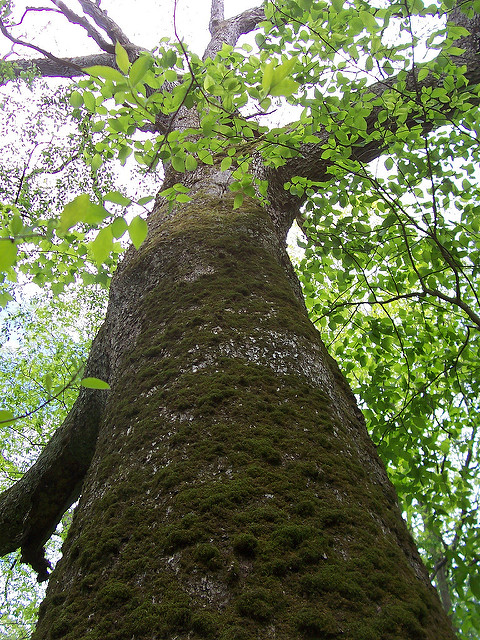A common misconception about trees is that the bigger they are, the older they are. This is not always true. Using size to gauge tree age is very similar to comparing people’s age to their size. Humans start small, hit a growth spurt, and remain mostly the same in size as they age; very hard to determine a number. This is also true with trees. There was a hemlock tree found by big tree hunter Will Blozan that was aged at 400 years but was only a little over 7 inches in diameter. So if size doesn’t help you, how do you know if you are in the presence of a 30 year old tree versus a 300 year old tree? You would look for signs of “old growth”.

This ancient oak is at the Newbold Estate near Irvine PA. Photo by Jeff Tome.
First and foremost, the only way to accurately measure the age of a tree is to drill a tree core and count the annual rings. Since the average outside adventurer doesn’t always carry a tree borer with them, there are some visual keys you can look for while hiking.
If you are in the presence of a forest with many old trees, signs of old growth can be numerous. An older tree will resemble a celery stalk; thick near the base, a long trunk to the top, with large branches clustered at the top. Another visual that gives away a tree’s age is the bark. Deep ridges or plates can be noted piling on top of each other; however this aspect can vary depending on species. Another sign you are in the presence of elderly trees is (ironically) evidence of dying, dead, and fallen trees. These trees provide nutrients into the ground and nesting opportunities for birds and small mammals and increase biodiversity and overall “health” of the forest. The ground of an old growth forest will be uneven; lots of mounds, buttress roots, and holes. This can illustrate lack of any recent human disturbance, yet another clue you are in an old growth forest.
The thing I love about living in Western New York is the ability to access so many different areas of preserved and protected land where I can see old growth forests. Allegany State Park is one of the largest intact forested landscapes in the state, and the largest forested landscape in Western New York. 5,000 acres of it are New York’s second largest old growth forest system consisting of eastern hemlocks. Zoar Valley is another area in Western New York with over 3,000 acres of preserved land rich in old growth. A small but local area in Chautauqua County is known for its old trees; Leolyn Woods in Lily Dale. This small but historic 10 acre area of old growth forest features northern red oaks, eastern hemlocks, red maples, cucumber magnolia and black cherry. These trees vary in age from 200 to 400 years old. Even here at Audubon Community Nature Center there are some oak and pine trees that have been guesstimated at around 200 years old.
The most important idea to take away from this blurb is that big trees don’t always mean old trees and to try to take note of your surroundings while out for a hike. Is the ground uneven? Are the branches of trees located ¾ of the way up the tree? Do you see a lot of downed trees? Are there deep ridges in the bark? All of the observations can help you figure out if you are in the presence of an old growth forest. Forests give us the ability to understand what truly belongs in the area and gives way to a greater biodiversity. Specifically, old growth forests are links to the past and hold key information about climate and the ecology of the land before. “There is no better way to save biodiversity than by preserving habitat, and no better habitat, species for species, than wilderness” says Edward O. Wilson.
Audubon Community Nature Center builds and nurtures connections between people and nature. ACNC is located just east of Route 62 between Warren and Jamestown. The trails are open from dawn to dusk as is Liberty, the Bald Eagle. The Nature Center is open from 10 a.m. until 4:30 p.m. daily except Sunday when it opens at 1 p.m. More information can be found online at auduboncnc.org or by calling (716) 569-2345.
Emily Rechin is a Seasonal Naturalist at ACNC.


Recent Comments